Between 25,000 and 30,000 Remington revolvers were manufactured during the years 1875-1889 in three different ammunition sizes: .44 Remington Center fire; .44-40; and .45 Long Colt. These were not optional; rather, the caliber of production models was determined by their date of manufacture. These revolvers were manufactured to be in direct competition with the new Colt Single Action Army that was introduced in 1873.
In 1868, Remington began offering five shot metallic cartridge conversions of the revolver in .46 rim fire. Remington paid a royalty fee to Smith & Wesson, owners of the Rollin White patent (#12,648, April 3, 1855) on bored-through revolver cylinders for metallic cartridge use. The 1858 Remington Army cartridge-conversions were the first large-caliber cartridge revolvers available, beating even Smith & Wesson’s .44 American to market by nearly two years.
When Rollin White’s request of extension for his breech-loading revolvers patent was rejected by the American Government in January 1870 the Colt’s Patent Fire Arms Manufacturing Company started working on its own metallic cartridge rear-loaders. Up until then, it had been only practicing the so-called Richards-Mason conversions. Colt continued converting muzzle-loading percussion revolvers into rear-loaders until 1878, but in 1871 Colt’s had patented at least two rear-loading revolvers using metallic cartridges: the Colt House Revolver and the Open Top. The House revolver went into production the same year in 1871 but the Open Top didn’t start production until 1872.
It was a failure of the 1871-1872 Colt Open top revolver in qualifying for the U.S. Army’s demand for a robust revolver that led Colt to design a completely new revolver that became the ‘standard’ from which other single-action revolvers are measured – the 1873 Colt Single Action Army.
The 1858 Remington Army conversions; however, were considered by some superior revolvers to the Colt and many were carried by civilians, law enforcement, and soldiers. However, the 1873 Colt Single Action Army was the Army’s choice of revolvers and Remington took a back seat. The 1875 Remington New Army; however, was still considered by many as the better revolver. In a sense, the Remington revolver was the Chevrolet to the Colt’s Ford.
The 1875 Remington New Army differed from the 1858 Remington Conversion in a few areas;
- 7-1/2 inch round barrel as compared to the 1858 8-inch barrel octagon
- Updated front sight
- A fluted cylinder
- Walnut grip panels
- Blued or nickel-plated finish with case-hardened hammer and loading gate. (The color-case hardened frame on the Uberti reproduction is not period correct – but it looks nice and has nice patterning.)
- Spring-loaded cartridge ejector rod replaced the no spring ejection rod of the 1858 model
- A completely redesigned frame. (Note that the cylinder pin lock on the Uberti reproduction is not correct, but was added by Uberti and is similar to the Colt).
- The 1875 Remington New Army was designed as a true cartridge revolver rather than a conversion like the 1858 model
- The loading gate was redesigned and resembles that of the Colt 1873 Single Action Army
- The firing pin is hammer mounted and protrudes through the frame; The 1858 Remington’s firing pin was internal to the frame.
- Lanyard ring
Standard barrel length was 7-1/2 inches (as with my model that, in the real world, would have been considered as the “Improved Army” revolver), although a very few revolvers were produced with 5-3/4 inch barrels (Uberti calls this the “Frontier” model). The familiar ‘sail’ was retained; however, and was perhaps a means to distinguish the Remington revolvers from the Colt line. The 1875 Remington New Army was the last revolver manufactured by Remington that incorporated the ‘sail’ in its design.
The 1875 Remington New Army was a robust revolver and tipped the scales at about 2.8 pounds (unloaded) as compared to the 1873 Colt Single Action Army that weighed about 2.3 pounds (unloaded).
The Uberti 1875 Remington ‘Outlaw” is a very close reproduction of the original revolver. With this version, the lanyard ring does not exist, as it was removed by many users at the time (honest folks as well as outlaws), and was not needed. However, some lanyard rings remained because many could not afford a good holster and these revolvers were stuffed into trousers and sashes; a makeshift lanyard could be used to keep from losing the revolver.
If one compares the 1875 Remington New Army with the Colt 1873 Single Action Army, one thing is apparent – the difference in grip. The 1873 Colt single Action Army back strap is more swept back, which allows the revolver to ‘roll’ or ‘plow’ in the hand. The back strap of the Remington 1875 Remington New Army is more downward and slightly inward. Although the grip is flared at the bottom, it is in my mind, more comparable to the Smith & Wesson No. 3 and Colt ‘Bisley’ revolvers, though not so pronounced. When shooting the Remington, it seems that the hand plays more of a part in recoil control than the Colt. The grip of the 1875 Remington New Army fits my hand better than the 1873 Colt Single Action Army. The front of the grip is also set back more than Colt revolvers; a feature that works well in my hands when on rare occasions when I shoot a single-action revolver two-handed.
With any single-action revolver based on early designs, the ‘load one-skip one-load four’ principle still applies. I do this even with modern single-action revolvers like the Ruger Blackhawk and other single-action revolvers – just to keep the habit alive. Also, I must be noted that the Uberti version of the 1875 Remington New Army does not incorporate and ‘hammer block’ safety as does the 1873 Colt Single Action Army and the Remington 1858 New Army Conversion model. The revolver definitely dictates the ‘load one-skip one-load four’ principle.
You might take note of the cylinder base pin on the 1875 Remington New Army revolver. Unlike the short cylinder base pin of the 1873 Colt Single Action Army, the cylinder base pin of the 1875 Remington New Army inserts into the long ‘sail’ of the revolver. On the original 1875 Remington New Army, the cylinder base pin was held into place by a spring latch system at the front of the cylinder base pin. The Uberti model differs from the original in that a spring loaded detent pin is used, like that found on the Colt 1873 Single Action Army.
The fit and finish on the Uberti 1875 ‘Outlaw’ model is very good but just short of excellent. While the bluing on the barrel assembly is excellent, the cylinder bluing is not uniform. This; however, is not a game stopper and in no way takes away from the performance of the revolver. The grip panels, at the back strap, are slightly rough and not exactly matched to the back strap. Some very light sanding and buffing are needed to smooth out the fit. Again, this is not a game stopper.

Nice Patterning on the Color Case Hardened Frame is a Nice Contrast With the Bluing of the Rest of the Revolver
The ‘color case hardened’ frame (not period correct, by the way) and hammer is nicely patterned and lends a nice contrast with the blue-steeled barrel assembly, trigger guard assembly, and the nicely-grained, two-piece grip panels. The grip panels are the only items that I would like to change on this revolver. As is common to Uberti firearms, the grip panels just seem too red to me. While I don’t think that a nice set of ‘aged stag’ grips would look good on this revolver, a nice set of dark walnut grip panels might. By the way, although Uberti also makes an 1875 Remington New Army revolver with a brass trigger guard, it is not period correct; the original revolver was all steel.
At the range, the Uberti 1875 Remington New Army is a pleasure to shoot. It is surprising how accurate these reproductions actually are and keeping all shots in a 4-inch circle at 15 yards, one-handed, is easy to do if you do your part.
The front sight was spot-on for a 6 o’clock hold with the POI about 1.5 inches high from POA at 15 yards. After shooting revolvers and pistols with a short sight radius, the 7.5-inch barrel on this beast is welcomed by my old eyes and I can see why folks of the past who carried these revolvers liked their accuracy.
The trigger pull on my particular revolver is just over 2.5 pounds of pull and has a crisp let-off with virtually no over-travel. The cylinder locks up tight and the ‘flash gap’ measures less than .004 inches. Using ‘Cowboy Grade’ 250-grain loads from PROGRADE, the Uberti 1875 Remington ‘Outlaw’ performed without a hitch.
Placing the hammer at half-cock and using the shell ejector, each expended shell ejected nicely and cleanly. In some cases, due to the light loads used, the expended .45 Colt shells just fell out from the chambers without prompting with the ejector rod. Load one, skip one, load four more and close the loading gate, pull the hammer to its full-cock position, control the hammer drop while pulling the trigger to place the firing pin on an empty cylinder, and you are ready to shoot again.
If you decide to practice (dry fire) with the revolver, I highly recommend the use of ‘snap caps’ and I prefer the A-Zoom snap caps over all others. Dry-firing these revolvers without ‘snap caps’ is not recommended, as it could damage the hammer-mounted firing pin. In fact, I use ‘snap caps’ for dry firing in any firearm to prevent possible damage to the firearm.
RANGE UPDATE 09/27/2015:
My second trip to the range revealed a flaw with the revolver. With the light loads of the ‘Cowboy Grade’ 250-grain loads from PROGRADE, there seemed to be no problem that I could detect. However, I was shooting a hotter 250-grain ‘Cowboy’ load from Georgia Arms (725 fps) on the second trip and this is when the problem reared its ugly head.
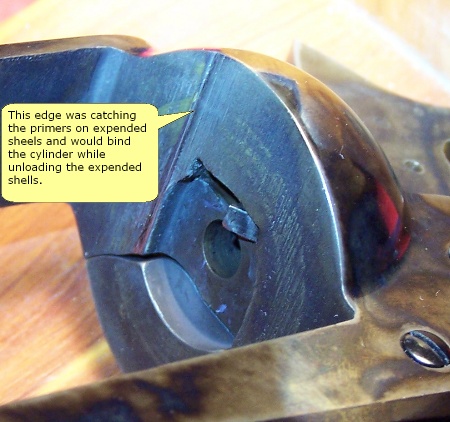 When attempting to unload the second round fired, the cylinder would bind to the point that it had to be removed. I looked closely at the base of the ammunition being fired and the recoil shield of the revolver. There was a step that was quite dominant in the machining of the frame. The step was dominant enough to catch my fingernail, and it seemed, dominant enough to catch the rim or primer of an expended shell casing.
When attempting to unload the second round fired, the cylinder would bind to the point that it had to be removed. I looked closely at the base of the ammunition being fired and the recoil shield of the revolver. There was a step that was quite dominant in the machining of the frame. The step was dominant enough to catch my fingernail, and it seemed, dominant enough to catch the rim or primer of an expended shell casing.
The frame was obviously machined this way by the manufacturer. In essence, the frame’s recoil shield is thicker behind the cartridge to be fired than in other places. I really don’t mind this at all, as this area takes the brunt of the recoiling shell casing and thicker is better. However, a graduated thickness is better than a step thickness.
Now, I could either send the revolver back for replacement/repair or attempt to rectify the situation myself. I decided on the latter. I needed to bevel the edge enough to allow a fired case and primer to slide over the step rather than coming to an abrupt stop.
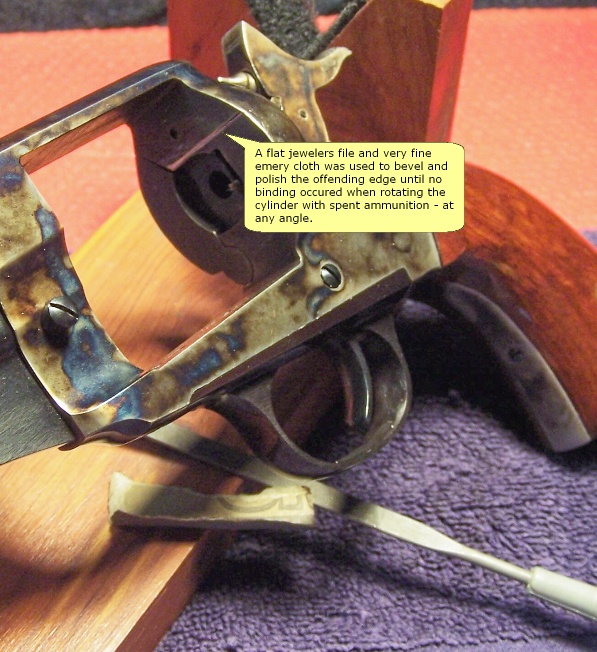 A jewelers flat file and a piece of extremely fine Emery cloth came into play. I lightly filed the offending step at about a 45-degree angle until the cylinder would not bind on any of the expended shells. This meant filing and fitting often. I did not want to remove too much metal, but just enough metal where I could not feel my fingernail catching on the step and cylinder drag could not be felt when the cylinder was rotated with expended cases. Once the step felt smooth, the very fine piece of Emory cloth was placed on the file and the step rubbed to remove file marks and lightly polish the surface of the now beveled edge. I finally reached a point where no binding was detected as the cylinder was rotated with once fired casings. At this point, it was time to stop any further filing and go for polishing only.
A jewelers flat file and a piece of extremely fine Emery cloth came into play. I lightly filed the offending step at about a 45-degree angle until the cylinder would not bind on any of the expended shells. This meant filing and fitting often. I did not want to remove too much metal, but just enough metal where I could not feel my fingernail catching on the step and cylinder drag could not be felt when the cylinder was rotated with expended cases. Once the step felt smooth, the very fine piece of Emory cloth was placed on the file and the step rubbed to remove file marks and lightly polish the surface of the now beveled edge. I finally reached a point where no binding was detected as the cylinder was rotated with once fired casings. At this point, it was time to stop any further filing and go for polishing only.
Sometimes you just have to go for it and hope for the best.
By the way, the first shot of Georgia Arms ‘Cowboy’ ammunition hit the ‘X’ at 15-yards. Subsequent shots were all in the ‘X’ ring from a standing “Duelist” position. This not a testament to my shooting, but it is a testament to the accuracy this revolver is capable of. With the 2.5 pound trigger in this revolver, one has to be cognizant of trigger control at all times when the hammer is cocked because surprise breaks are the norm.
WRAPPING IT UP:
There were many for whom the 1875 Remington New Army was the weapon of choice; among them are Buffalo Bill Cody (whose piece is in the Cody Museum with a hand-written note by Cody “It never failed me.”) and by outlaws Frank and Jesse James. The 1875 Remington New Army was also carried by the agents who murdered Chief Sitting Bull; however, it is claimed that the predecessor of the 1875, an 1890 New Army, was used to actually dispatch Sitting Bull. The 1875 has been featured in numerous films, including being carried by Ned Pepper (played by Robert Duvall in the early version of True Grit) and carried by Bruce Dern in the western “Will Penny”. The Remington 1875 SAA was Sheriff Seth Bullock’s firearm throughout the series “Deadwood”.
The 1875 Remington New Army revolver was, in my mind, that last ‘true’ Remington revolver as the ‘sail’ was non-existent with Remington’s 1888 (New Army Pocket) and 1890 (New Model Army) revolvers. I do have to say that having a reproduction of the Remington 1890 New Model Army revolver is tempting, as the original was manufactured in limited numbers and is a highly desirable collectible. I; however, would have to settle with an excellent reproduction of this revolver and that is fine with me. Author’s Note: Click here to read a review of the Remington 1890 New Model Army revolver.
The Uberti 1875 Remington “Outlaw” New Army revolver is a fine example of the original only with modern materials and manufacturing. Take a break from modern firearms, slow down, and step back into history for a bit while shooting reproductions of the revolvers that helped to bring handguns into the modern age. A time when real ‘gun control’ was determined by how well you handled a handgun, rifle, and shotgun. Come to think of it, that fact remains still today.
RESOURCES:
Remington Model 1875: https://en.wikipedia.org/wiki/Remington_Model_1875
Outlaw, Frontier & Police Revolvers: http://www.uberti.com/outlaw-frontier-and-police-revolvers
A-Zoom Snap Caps: http://www.azoomsnapcaps.com/home/
![]()


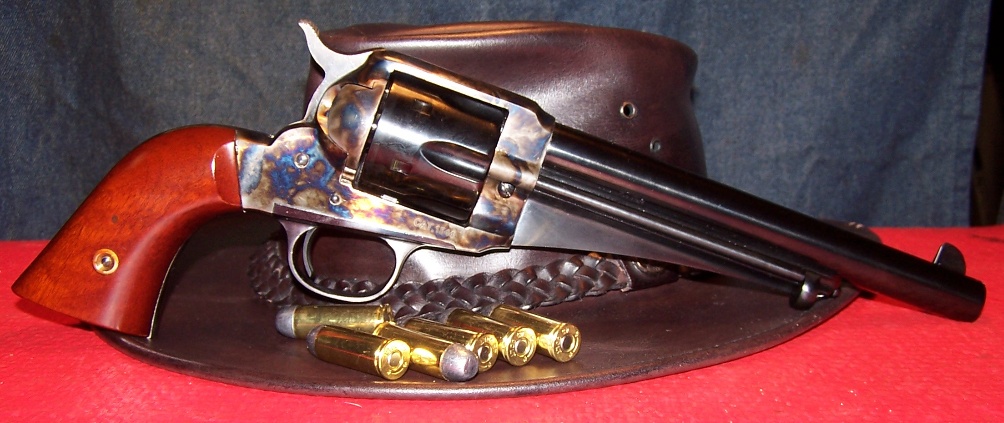
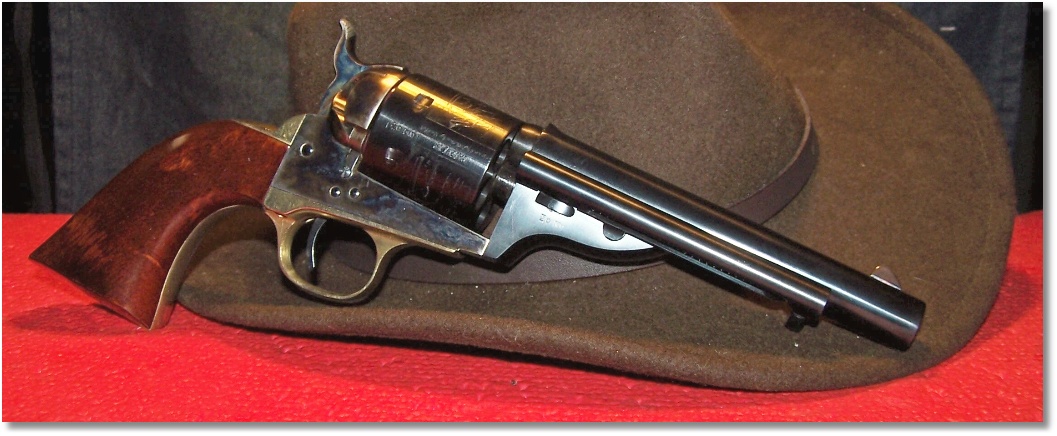

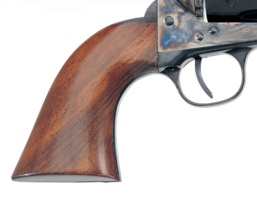
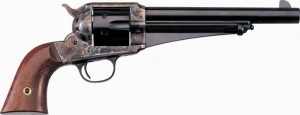
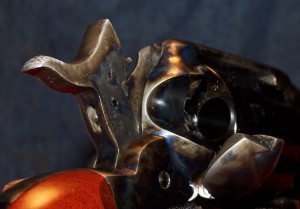
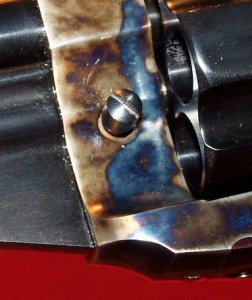
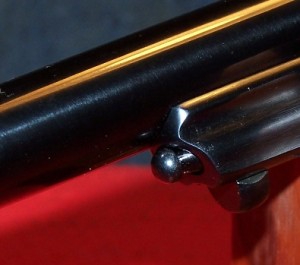
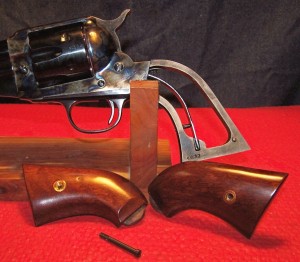

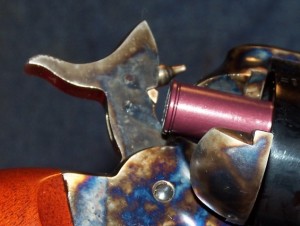
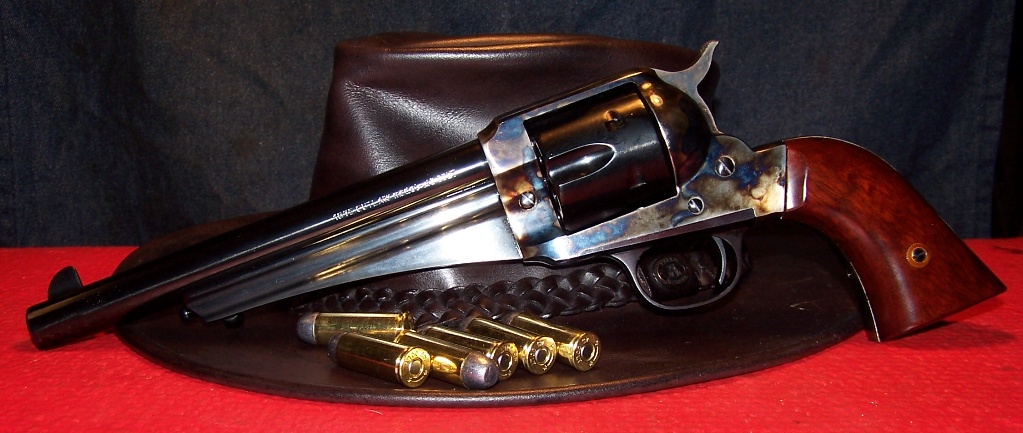
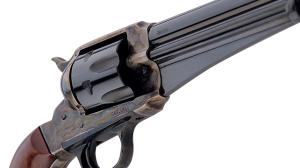

5 Responses to 1875 Remington ‘Outlaw’ by A. Uberti